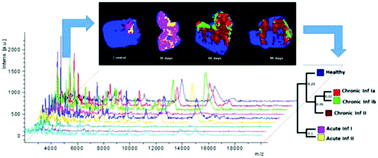MALDI MS imaging investigation of the host response to visceral leishmaniasis†
Abstract
Mass spectrometry imaging (MSI) of animal tissues has become an important tool for in situ molecular analyses and biomarker studies in several clinical areas, but there are few applications in parasitological studies. Leishmaniasis is a neglected tropical disease, and experimental mouse models have been essential to evaluate pathological and immunological processes and to develop diagnostic methods. Herein we have employed MALDI MSI to examine peptides and low molecular weight proteins (2 to 20 kDa) differentially expressed in the liver during visceral leishmaniasis in mice models. We analyzed liver sections of Balb/c mice infected with Leishmania infantum using the SCiLS Lab software for statistical analysis, which facilitated data interpretation and thus highlighted several key proteins and/or peptides. We proposed a decision tree classification for visceral leishmaniasis with distinct phases of the disease, which are named here as healthy, acute infection and chronic infection. Among others, the ion of m/z 4963 was the most important to identify acute infection and was tentatively identified as Thymosin β4. This peptide was previously established as a recovery factor in the human liver and might participate in the response of mice to Leishmania infection. This preliminary investigation shows the potential of MALDI MSI to complement classical compound selective imaging techniques and to explore new features not yet recognized by these approaches.



 Please wait while we load your content...
Please wait while we load your content...